Effect of Elevated Temperature on the Behavior of Amorphous Metallic Fibre-Reinforced Cement and Geopolymer Composites
Abstract
1. Introduction
2. Experimental Program
2.1. Materials
2.2. Specimen Preparation
2.2.1. Casting and Curing
2.2.2. Exposure to Elevated Temperatures
2.3. Experimental Test-Setup
3. Results and Discussions
3.1. Post-Heating Physical Properties
3.2. Residual Compressive Strength
3.3. Residual Flexural Strength
3.4. Microstructure Analysis of Cement and Geopolymer Composites
4. Conclusions
- The average mass loss in unreinforced and AMF reinforced cement composites was higher than their geopolymer counterparts at all elevated temperatures.
- Cracking was negligible in both the AMF reinforced cement and geopolymer composites up to 400 °C. At 600 °C and 800 °C temperatures the AMF reinforced geopolymer composites exhibited no cracking.
- The compressive strength of AMF reinforced geopolymer composites was higher than that of cement composites at all temperature levels. The residual compressive strength of reinforced cement composites at 200 °C, 400 °C, 600 °C, and 800 °C was 88%, 76%, 44%, and 45% to that of the strength at ambient temperature. The corresponding residual strength of reinforced geopolymer composites was 110%, 74%, 49%, 45%.
- Similar to the compressive strength, the flexural strength of the composites also reduced with increasing temperature and the flexural strength of the AMF reinforced geopolymer composites was higher than that of cement composites at all elevated temperatures. The residual flexural strengths of AMF reinforced cement composites at 200 °C, 400 °C, 600 °C were 76%, 78% respectively, while the residual flexural strengths of AMF reinforced geopolymer composites at 200 °C, 400 °C, 600 °C, and 800 °C were 80%, 81%, 43%, and 45% to that of the strength at ambient temperature.
- Scanning electron microscopic images also showed increased deterioration of cement composites at higher temperatures than the geopolymer composites. At the temperature of 800 °C, a negligible amount of cement matrix was present on the fibres which results in significant cracking and lower residual strengths than the geopolymer composites in which a higher amount of geopolymer matrix was still present on the fibres. The superior fire resisting properties of the geopolymer matrix also help in the retention of the fibre integrity at elevated temperatures.
Author Contributions
Funding
Data Availability Statement
Conflicts of Interest
References
- Huntzinger, D.N.; Eatmon, T.D. A life-cycle assessment of Portland cement manufacturing: Comparing the traditional process with alternative technologies. J. Clean. Prod. 2009, 17, 668–675. [Google Scholar] [CrossRef]
- Davidovits, J. Soft mineralurgy and geopolymers. In Proceedings of the Geopolymer 88 International Conference, the Université de Technologie, Compiègne, France, 1–3 June 1988; Volume 88, pp. 49–56. [Google Scholar]
- Davidovits, J. High-alkali cements for 21st century concretes. Spec. Publ. 1994, 144, 383–398. [Google Scholar]
- Al-Mashhadani, M.M.; Canpolat, O.; Aygörmez, Y.; Uysal, M.; Erdem, S. Mechanical and microstructural characterization of fibre reinforced fly ash based geopolymer composites. Constr. Build. Mater. 2018, 167, 505–513. [Google Scholar] [CrossRef]
- Li, Z.; Ding, Z.; Zhang, Y. Development of Sustainable Cementitious Materials. In Proceedings of the International Workshop on Sustainable Development and Concrete Technology, Beijing, China, 20–21 May 2004; pp. 55–76. [Google Scholar]
- Duxson, P.; Provis, J.L.; Lukey, G.C.; Van Deventer, J.S.J. The role of inorganic polymer technology in the development of ‘green concrete’. Cem. Concr. Res. 2007, 37, 1590–1597. [Google Scholar] [CrossRef]
- Huang, C.-H.; Lin, S.-K.; Chang, C.-S.; Chen, H.-J. Mix proportions and mechanical properties of concrete containing very high-volume of Class F fly ash. Constr. Build. Mater. 2013, 46, 71–78. [Google Scholar] [CrossRef]
- Mehta, P.K. Pozzolanic and cementitious byproducts as mineral admixtures for concrete-a critical review. Spec. Publ. 1983, 79, 1–46. [Google Scholar]
- Swanepoel, J.C.; Strydom, C.A. Utilisation of fly ash in a geopolymeric material. Appl. Geochem. 2002, 17, 1143–1148. [Google Scholar] [CrossRef]
- Malhotra, V.M. Fly ash, slag, silica fume, and rice husk ash in concrete: A review. Concr. Int. 1993, 15, 23–28. [Google Scholar]
- Olivia, M.; Nikraz, H. Properties of fly ash geopolymer concrete designed by Taguchi method. Mater. Des. 2012, 36, 191–198. [Google Scholar] [CrossRef]
- Phoo-ngernkham, T.; Maegawa, A.; Mishima, N.; Hatanaka, S.; Chindaprasirt, P. Effects of sodium hydroxide and sodium silicate solutions on compressive and shear bond strengths of FA–GBFS geopolymer. Constr. Build. Mater. 2015, 91, 1–8. [Google Scholar] [CrossRef]
- Phoo-Ngernkham, T.; Sata, V.; Hanjitsuwan, S.; Ridtirud, C.; Hatanaka, S.; Chindaprasirt, P. High calcium fly ash geopolymer mortar containing Portland cement for use as repair material. Constr. Build. Mater. 2015, 98, 482–488. [Google Scholar] [CrossRef]
- Hardjito, D.; Wallah, S.E.; Sumajouw, D.M.J.; Rangan, B.V. On the development of fly ash-based geopolymer concrete. Mater. J. 2004, 101, 467–472. [Google Scholar]
- Wallah, S.; Rangan, B.V. Low-Calcium Fly Ash-based Geopolymer Concrete: Long-Term Properties; Curtin University: Perth, WA, Australia, 2006. [Google Scholar]
- Kong, D.L.Y.; Sanjayan, J.G. Effect of elevated temperatures on geopolymer paste, mortar and concrete. Cem. Concr. Res. 2010, 40, 334–339. [Google Scholar] [CrossRef]
- Sarker, P.K. Analysis of geopolymer concrete columns. Mater. Struct. 2009, 42, 715–724. [Google Scholar] [CrossRef]
- Shaikh, F.U.A.; Singh, A.S.D.; Pandra, A. Mechanical Properties of Amorphous Metallic Fibre–Reinforced Geopolymer Composites. J. Mater. Civ. Eng. 2022, 34, 1–14. [Google Scholar] [CrossRef]
- Choi, S.-J.; Hong, B.-T.; Lee, S.-J.; Won, J.-P. Shrinkage and corrosion resistance of amorphous metallic-fibre-reinforced cement composites. Compos. Struct. 2014, 107, 537–543. [Google Scholar] [CrossRef]
- Yang, J.-M.; Shin, H.-O.; Yoo, D.-Y. Benefits of using amorphous metallic fibres in concrete pavement for long-term performance. Arch. Civ. Mech. Eng. 2017, 17, 750–760. [Google Scholar] [CrossRef]
- Kim, H.; Kim, G.; Nam, J.; Kim, J.; Han, S.; Lee, S. Static mechanical properties and impact resistance of amorphous metallic fibre-reinforced concrete. Compos. Struct. 2015, 134, 831–844. [Google Scholar] [CrossRef]
- Choi, K.-K.; Ku, D.-O. Flexural behaviour of amorphous metal-fibre-reinforced concrete. Proc. Inst. Civ. Eng. Build. 2015, 168, 15–25. [Google Scholar] [CrossRef]
- Shaikh, F.U.A. Pullout behavior of hook end steel fibres in geopolymers. J. Mater. Civ. Eng. 2019, 31, 4019068. [Google Scholar] [CrossRef]
- Khan, M.Z.N.; Shaikh, F.U.A.; Hao, Y.; Hao, H. Effects of curing conditions and sand-to-binder ratios on compressive strength development of fly ash geopolymer. J. Mater. Civ. Eng. 2018, 30, 4017267. [Google Scholar] [CrossRef]
- Khan, M.Z.N.; Hao, Y.; Hao, H. Synthesis of high strength ambient cured geopolymer composite by using low calcium fly ash. Constr. Build. Mater. 2016, 125, 809–820. [Google Scholar] [CrossRef]
- Cheng, T.-W.; Chiu, J.P. Fire-resistant geopolymer produced by granulated blast furnace slag. Miner. Eng. 2003, 16, 205–210. [Google Scholar] [CrossRef]
- Barbosa, V.F.F.; MacKenzie, K.J.D. Synthesis and thermal behaviour of potassium sialate geopolymers. Mater. Lett. 2003, 57, 1477–1482. [Google Scholar] [CrossRef]
- Barbosa, V.F.F.; MacKenzie, K.J.D. Thermal behaviour of inorganic geopolymers and composites derived from sodium polysialate. Mater. Res. Bull. 2003, 38, 319–331. [Google Scholar] [CrossRef]
- Buchwald, A.; Hohmann, M.; Kaps, C.; Bettzieche, H.; Kühnert, J.-T. Stabilised foam clay material with high performance thermal insulation properties. CFI (Ceram. Forum Int. Ber. DKG) 2004, 81, E39–E42. [Google Scholar]
- Rickard, W.D.A.; Vickers, L.; Van Riessen, A. Performance of fibre reinforced, low density metakaolin geopolymers under simulated fire conditions. Appl. Clay Sci. 2013, 73, 71–77. [Google Scholar] [CrossRef]
- Choi, Y.C.; Park, B. Effects of high-temperature exposure on fractal dimension of fly ash-based geopolymer composites. J. Mater. Res. Technol. 2020, 9, 7655–7668. [Google Scholar] [CrossRef]
- Rickard, W.D.A.; Temuujin, J.; van Riessen, A. Thermal analysis of geopolymer pastes synthesised from five fly ashes of variable composition. J. Non. Cryst. Solids 2012, 358, 1830–1839. [Google Scholar] [CrossRef]
- Abdulkareem, O.A.; Al Bakri, A.M.M.; Kamarudin, H.; Nizar, I.K.; Ala’eddin, A.S. Effects of elevated temperatures on the thermal behavior and mechanical performance of fly ash geopolymer paste, mortar and lightweight concrete. Constr. Build. Mater. 2014, 50, 377–387. [Google Scholar] [CrossRef]
- Ranjbar, N.; Mehrali, M.; Alengaram, U.J.; Metselaar, H.S.C.; Jumaat, M.Z. Compressive strength and microstructural analysis of fly ash/palm oil fuel ash based geopolymer mortar under elevated temperatures. Constr. Build. Mater. 2014, 65, 114–121. [Google Scholar] [CrossRef]
- Shaikh, F.U.A.; Vimonsatit, V. Compressive strength of fly-ash-based geopolymer concrete at elevated temperatures. Fire Mater. 2015, 39, 174–188. [Google Scholar] [CrossRef]
- Kong, D.L.Y.; Sanjayan, J.G. Damage behavior of geopolymer composites exposed to elevated temperatures. Cem. Concr. Compos. 2008, 30, 986–991. [Google Scholar] [CrossRef]
- Guerrieri, M.; Sanjayan, J.G. Behavior of combined fly ash/slag-based geopolymers when exposed to high temperatures. Fire Mater. An Int. J. 2010, 34, 163–175. [Google Scholar] [CrossRef]
- Masi, G.; Rickard, W.D.A.; Bignozzi, M.C.; Van Riessen, A. The effect of organic and inorganic fibres on the mechanical and thermal properties of aluminate activated geopolymers. Compos. Part B Eng. 2015, 76, 218–228. [Google Scholar] [CrossRef]
- Fiore, V.; Scalici, T.; Di Bella, G.; Valenza, A. A review on basalt fibre and its composites. Compos. Part B Eng. 2015, 74, 74–94. [Google Scholar] [CrossRef]
- Welter, M.; Schmücker, M.; MacKenzie, K.J.D. Evolution of the fibre-matrix interactions in basalt-fibre-reinforced geopolymer-matrix composites after heating. J. Ceram. Sci. Technol. 2015, 6, 17–24. [Google Scholar]
- Hosan, A.; Haque, S.; Shaikh, F. Compressive behaviour of sodium and potassium activators synthetized fly ash geopolymer at elevated temperatures: A comparative study. J. Build. Eng. 2016, 8, 123–130. [Google Scholar] [CrossRef]
- Zhang, H.; Kodur, V.; Cao, L.; Qi, S. Fibre reinforced geopolymers for fire resistance applications. Procedia Eng. 2014, 71, 153–158. [Google Scholar] [CrossRef]
- RILEM TC. 129-MHT: Test methods for mechanical properties of concrete at high temperatures. Mater. Struct. 1995, 28, 410–414. [Google Scholar]
- AS 1012.9; Methods of Testing Concrete—Compressive Strength Tests—Concrete, Mortar and Grout Specimens. Standards Australia: Sydney, Australia, 2014.
- Lau, A.; Anson, M. Effect of high temperatures on high performance steel fibre reinforced concrete. Cem. Concr. Res. 2006, 36, 1698–1707. [Google Scholar] [CrossRef]
- Shaikh, F.U.A.; Hosan, A. Mechanical properties of steel fibre reinforced geopolymer concretes at elevated temperatures. Constr. Build. Mater. 2016, 114, 15–28. [Google Scholar] [CrossRef]
- Düğenci, O.; Haktanir, T.; Altun, F. Experimental research for the effect of high temperature on the mechanical properties of steel fibre-reinforced concrete. Constr. Build. Mater. 2015, 75, 82–88. [Google Scholar] [CrossRef]
- Khoury, G.A. Effect of fire on concrete and concrete structures. Prog. Struct. Eng. Mater. 2000, 2, 429–447. [Google Scholar] [CrossRef]
- Zhang, P.; Kang, L.; Wang, J.; Guo, J.; Hu, S.; Ling, Y. Mechanical properties and explosive spalling behavior of steel-fibre-reinforced concrete exposed to high temperature-A review. Appl. Sci. 2020, 10, 2324. [Google Scholar] [CrossRef]
- Poon, C.S.; Shui, Z.H.; Lam, L. Compressive behavior of fibre reinforced high-performance concrete subjected to elevated temperatures. Cem. Concr. Res. 2004, 34, 2215–2222. [Google Scholar] [CrossRef]
- Chen, B.; Liu, J. Residual strength of hybrid-fibre-reinforced high-strength concrete after exposure to high temperatures. Cem. Concr. Res. 2004, 34, 1065–1069. [Google Scholar] [CrossRef]
- Bezerra, C.S.; Maciel, P.S.; Corrêa, E.C.S.; Junior, P.R.R.S.; Aguilar, M.T.P.; Cetlin, P.R. Effect of high temperature on the mechanical properties of steel fibre-reinforced concrete. Fibres 2019, 7, 100. [Google Scholar] [CrossRef]
- Chen, H.-G.; Liu, F.Y.; Sun, B.; Wang, M.; Cheng, P.-J. Impact of steel fibre dosage on mechanical properties of concrete under high temperature. J. Chongqing Jiaotong Univ. 2010, 29, 552–554. [Google Scholar]
- Ismail, R.; Zakwan, F.A.A.; Petrus, C.; Marzuki, N.A.; Hashim, N.H.; Mustafa, M.F. Compressive behavior of steel fibre reinforced concrete after exposed to high temperatures. In CIEC 2013; Springer: Berlin/Heidelberg, Germany, 2014; pp. 731–740. [Google Scholar]
- Colombo, M.; Di Prisco, M.; Felicetti, R. Mechanical properties of steel fibre reinforced concrete exposed at high temperatures. Mater. Struct. Constr. 2010, 43, 475–491. [Google Scholar] [CrossRef]
- Li, L.; Zhang, R.; Jin, L.; Du, X.; Wu, J.; Duan, W. Experimental study on dynamic compressive behavior of steel fibre reinforced concrete at elevated temperatures. Constr. Build. Mater. 2019, 210, 673–684. [Google Scholar] [CrossRef]
- Pliya, P.; Beaucour, A.L.; Noumowé, A. Contribution of cocktail of polypropylene and steel fibres in improving the behaviour of high strength concrete subjected to high temperature. Constr. Build. Mater. 2011, 25, 1926–1934. [Google Scholar] [CrossRef]
- Choumanidis, D.; Badogiannis, E.; Nomikos, P.; Sofianos, A. The effect of different fibres on the flexural behaviour of concrete exposed to normal and elevated temperatures. Constr. Build. Mater. 2016, 129, 266–277. [Google Scholar] [CrossRef]
- Jameran, A.; Ibrahim, I.S.; Yazan, S.H.S.; Rahim, S.N.A.A. Mechanical properties of steel-polypropylene fibre reinforced concrete under elevated temperature. Procedia Eng. 2015, 125, 818–824. [Google Scholar] [CrossRef]
- Nielsen, C.V.; Biéanić, N. Residual fracture energy of high-performance and normal concrete subject to high temperatures. Mater. Struct. 2003, 36, 515–521. [Google Scholar] [CrossRef]
- Menou, A.; Mounajed, G.; Boussa, H.; Pineaud, A.; Carre, H. Residual fracture energy of cement paste, mortar and concrete subject to high temperature. Theor. Appl. Fract. Mech. 2006, 45, 64–71. [Google Scholar] [CrossRef]
- Lahoti, M.; Tan, K.H.; Yang, E.-H. A critical review of geopolymer properties for structural fire-resistance applications. Constr. Build. Mater. 2019, 221, 514–526. [Google Scholar] [CrossRef]
- Amran, M.; Huang, S.-S.; Debbarma, S.; Rashid, R.S.M. Fire resistance of geopolymer concrete: A critical review. Constr. Build. Mater. 2022, 324, 126722. [Google Scholar] [CrossRef]
- Ahmad, S.; Rasul, M.; Adekunle, S.K.; Al-Dulaijan, S.U.; Maslehuddin, M.; Ali, S.I. Mechanical properties of steel fibre-reinforced UHPC mixtures exposed to elevated temperature: Effects of exposure duration and fibre content. Compos. Part B Eng. 2019, 168, 291–301. [Google Scholar] [CrossRef]

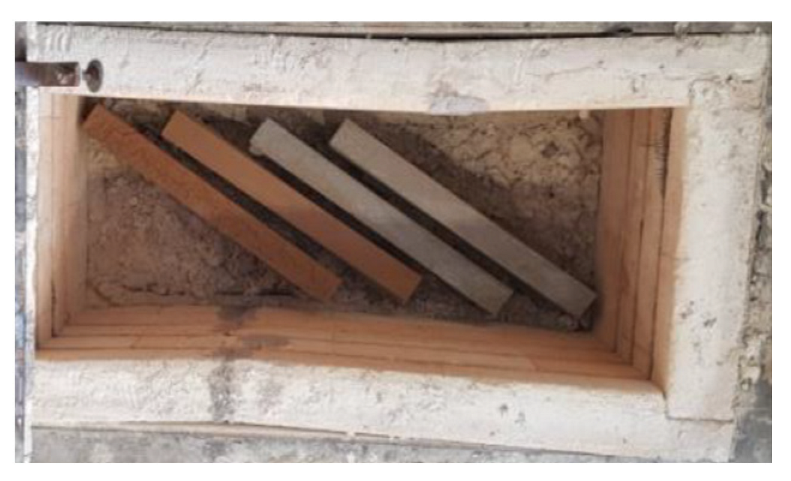
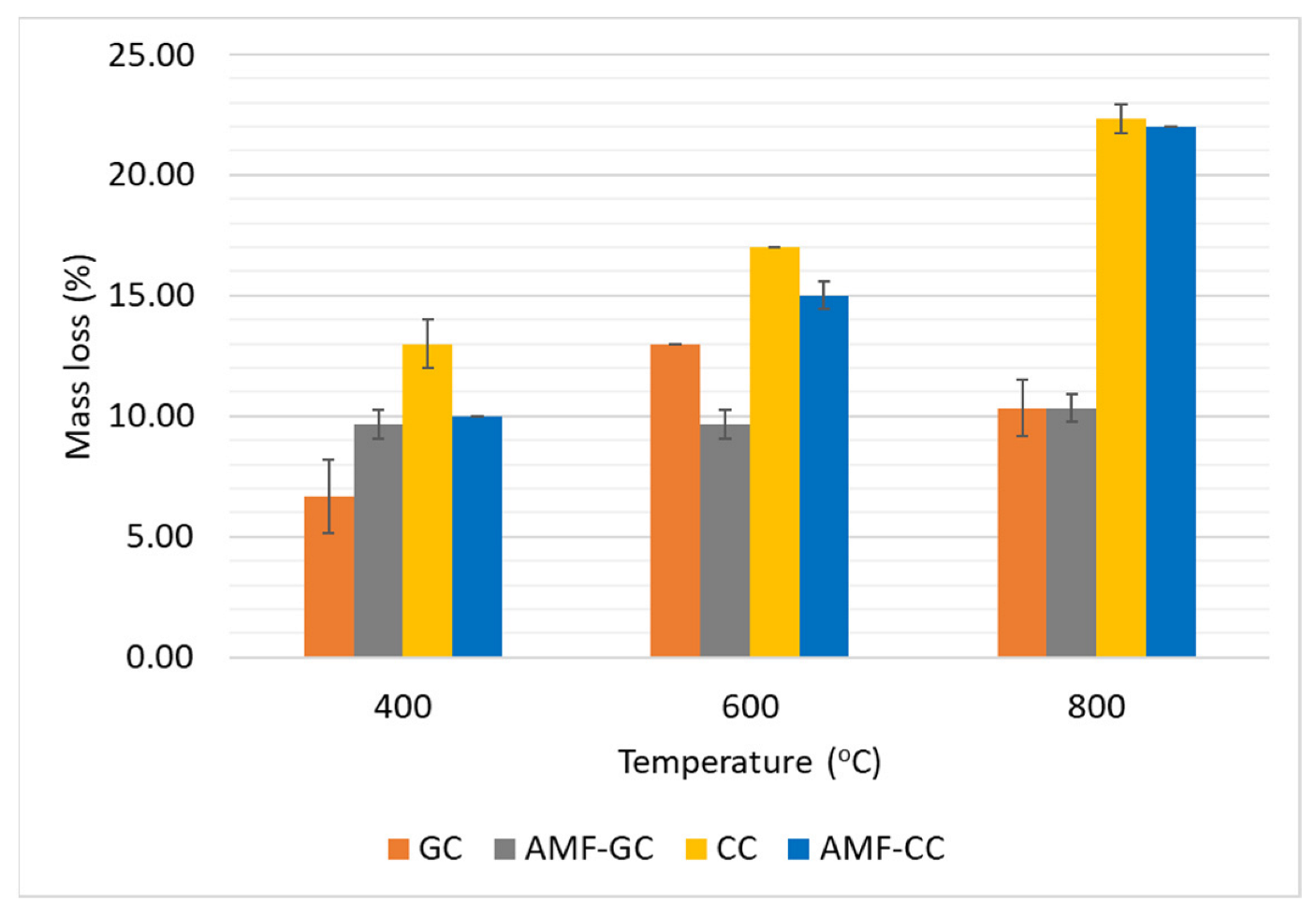



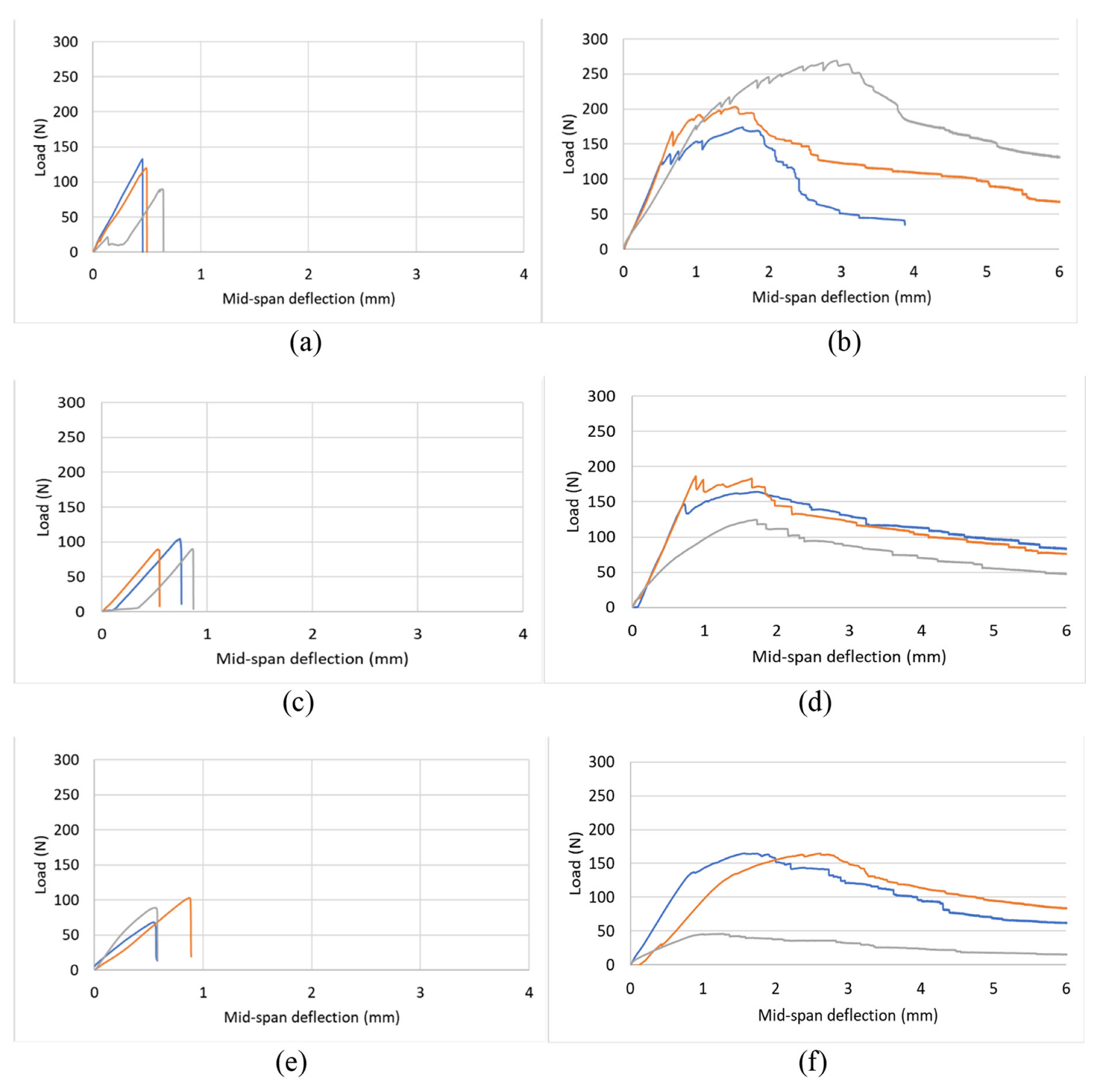
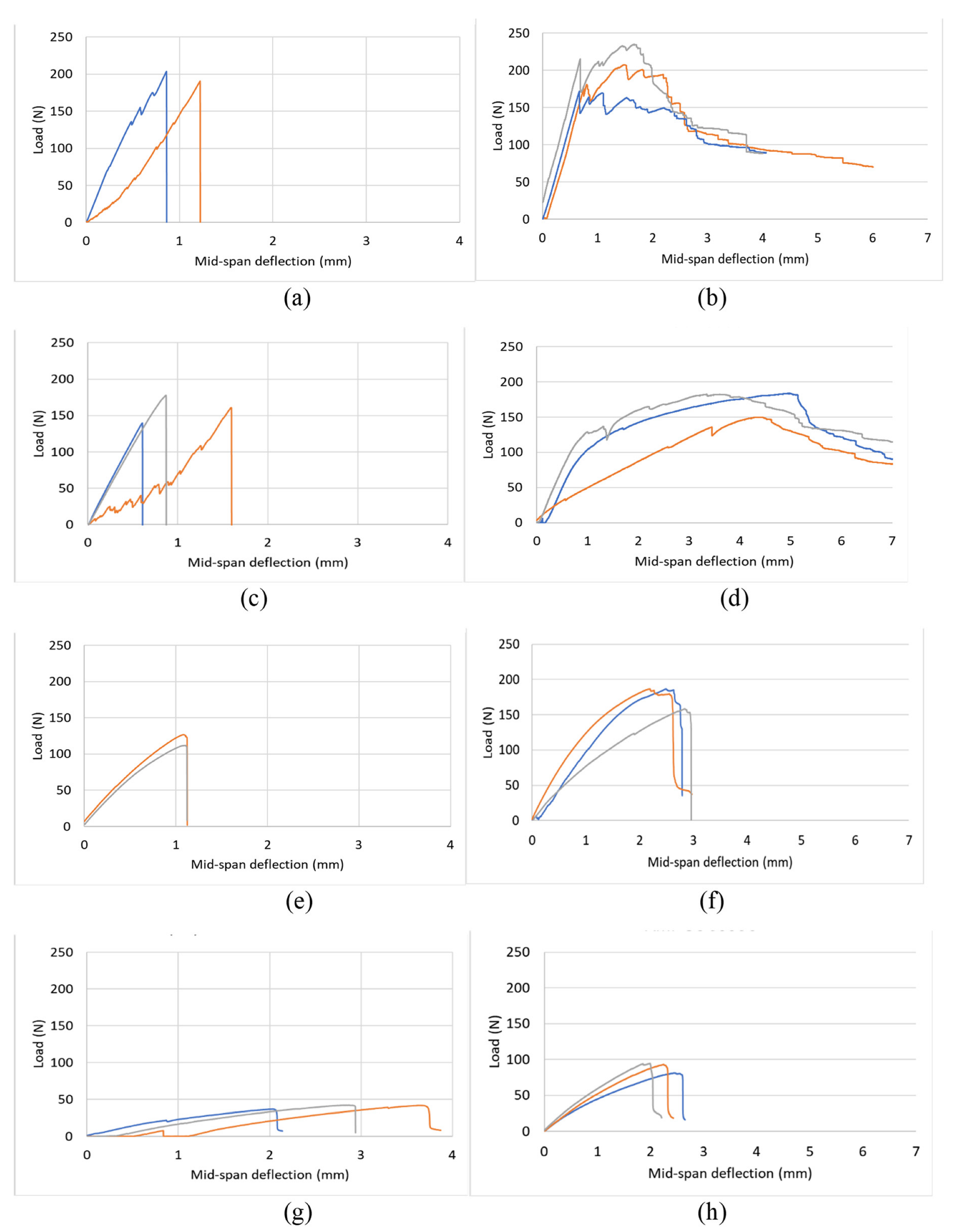

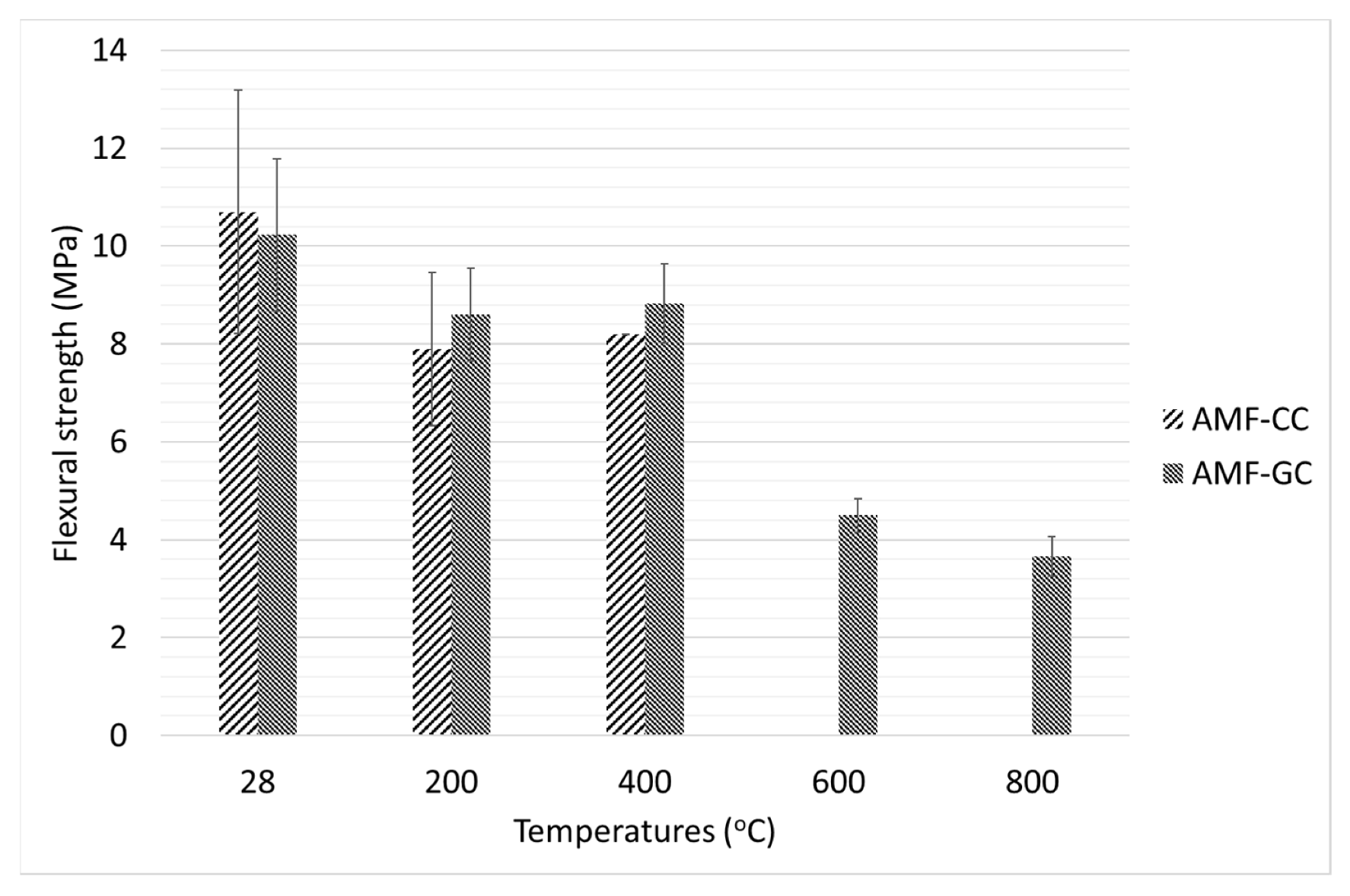


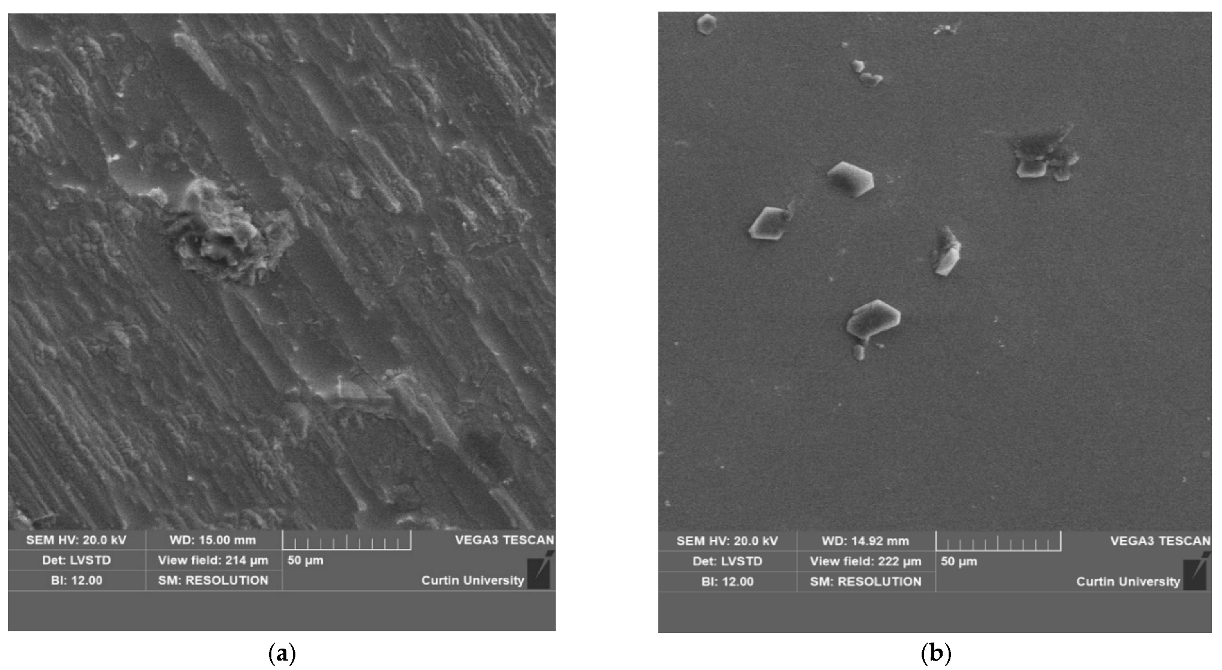
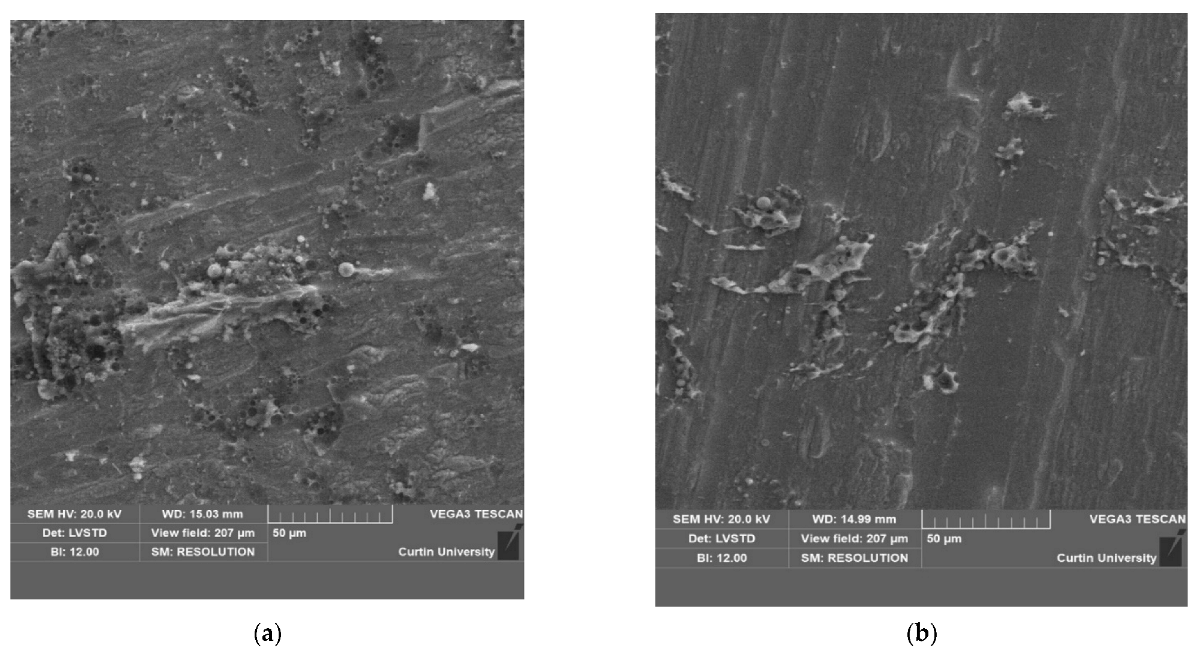
| Chemical Composition | OPC | Class F Fly Ash |
|---|---|---|
| SiO2 | 21.10 | 51.11 |
| Al2O3 | 5.24 | 25.56 |
| Fe2O3 | 3.10 | 12.48 |
| CaO | 64.39 | 4.3 |
| MgO | 1.10 | 1.45 |
| K2O | 0.57 | 0.7 |
| Na2O | 0.23 | 0.77 |
| SO3 | 2.52 | 0.24 |
| LOI | 1.22 | 0.57 |
| Particle size | 25%–40% ≤ 7 µm | 50% of 10 µm |
| Specific gravity | 2.7 | 2.35–2.4 |
| Composite | Binder | Sand | Alkali Activator (Weight) | Water (Weight) | AMF (Volume) | ||
|---|---|---|---|---|---|---|---|
| Cement | Fly Ash | NaOH | Na2SiO3 | ||||
| CC | 1 | - | 0.5 | - | - | 0.5 | - |
| AMF-CC | 1 | - | 0.5 | - | - | 0.5 | 0.75% |
| GC | - | 1 | 0.5 | 0.15 | 0.35 | - | - |
| AMF-GC | - | 1 | 0.5 | 0.15 | 0.35 | - | 0.75% |
| Study | Fibre Content | Strength | Temperature (°C) | ||||
|---|---|---|---|---|---|---|---|
| Ambient | 200 | 400 | 600 | 800 | |||
| Present study | 0.75% | Compressive strength (MPa) | 66 | 58 | 50 | 29 | 29 |
| Residual strength (%) | 88 | 76 | 44 | 44 | |||
| Shaikh and Hosan [46] | 0.75% | Compressive strength (MPa) | 48 | 42 | 40 | 27 | 20 |
| Residual strength (%) | 88 | 83 | 56 | 42 | |||
| Lau and Anson [45] | 1% | Compressive strength (MPa) | 45 | 34 | 30 | 20 | 12 |
| Residual strength (%) | 76 | 67 | 44 | 27 | |||
| Compressive strength (MPa) | 60 | 48 | 40 | 33 | 17 | ||
| Residual strength (%) | 80 | 67 | 55 | 28 | |||
| Colombo et al. [55] | 2% | Compressive strength (MPa) | 75 | 62 | 59 | 47 | - |
| Residual strength (%) | 83 | 78 | 63 | - | |||
| Li et al. [56] | 1% | Compressive strength (MPa) | 40 | 38 | 48 | 29 | 8 |
| Residual strength (%) | 95 | 120 | 73 | 20 | |||
| 2% | Compressive strength (MPa) | 37 | 36 | 40 | 34 | 7 | |
| Residual strength (%) | 97 | 108 | 92 | 19 | |||
| Ismail et al. [54] | 0.50% | Compressive strength (MPa) | 52 | 49 | 50 | 42 | 38 |
| Residual strength (%) | 95 | 97 | 81 | 74 | |||
| Study | Fibre Content | Strength | Temperature (°C) | ||||
|---|---|---|---|---|---|---|---|
| Ambient | 200 | 400 | 600 | 800 | |||
| Present study | 0.75% | Flexural strength (MPa) | 10.8 | 7.9 | 8.1 | - | - |
| Residual strength (%) | 73 | 75 | - | - | |||
| Lau and Anson [45] | 1% | Flexural strength (MPa) | 6 | 5 | 3 | 1.2 | 0.1 |
| Residual strength (%) | 83 | 50 | 20 | 2 | |||
| Flexural strength (MPa) | 8 | 7 | 4 | 2.8 | 1 | ||
| Residual strength (%) | 88 | 50 | 35 | 13 | |||
| Colombo et al. [55] | 2% | Flexural strength (MPa) | 4 | 3 | 2 | 2 | - |
| Residual strength (%) | 84 | 45 | 39 | - | |||
Disclaimer/Publisher’s Note: The statements, opinions and data contained in all publications are solely those of the individual author(s) and contributor(s) and not of MDPI and/or the editor(s). MDPI and/or the editor(s) disclaim responsibility for any injury to people or property resulting from any ideas, methods, instructions or products referred to in the content. |
© 2023 by the authors. Licensee MDPI, Basel, Switzerland. This article is an open access article distributed under the terms and conditions of the Creative Commons Attribution (CC BY) license (https://creativecommons.org/licenses/by/4.0/).
Share and Cite
Shaikh, F.U.A.; Kahlon, N.S.; Dogar, A.U.R. Effect of Elevated Temperature on the Behavior of Amorphous Metallic Fibre-Reinforced Cement and Geopolymer Composites. Fibers 2023, 11, 31. https://doi.org/10.3390/fib11040031
Shaikh FUA, Kahlon NS, Dogar AUR. Effect of Elevated Temperature on the Behavior of Amorphous Metallic Fibre-Reinforced Cement and Geopolymer Composites. Fibers. 2023; 11(4):31. https://doi.org/10.3390/fib11040031
Chicago/Turabian StyleShaikh, Faiz Uddin Ahmed, Narwinder Singh Kahlon, and Attiq Ur Rahman Dogar. 2023. "Effect of Elevated Temperature on the Behavior of Amorphous Metallic Fibre-Reinforced Cement and Geopolymer Composites" Fibers 11, no. 4: 31. https://doi.org/10.3390/fib11040031
APA StyleShaikh, F. U. A., Kahlon, N. S., & Dogar, A. U. R. (2023). Effect of Elevated Temperature on the Behavior of Amorphous Metallic Fibre-Reinforced Cement and Geopolymer Composites. Fibers, 11(4), 31. https://doi.org/10.3390/fib11040031









